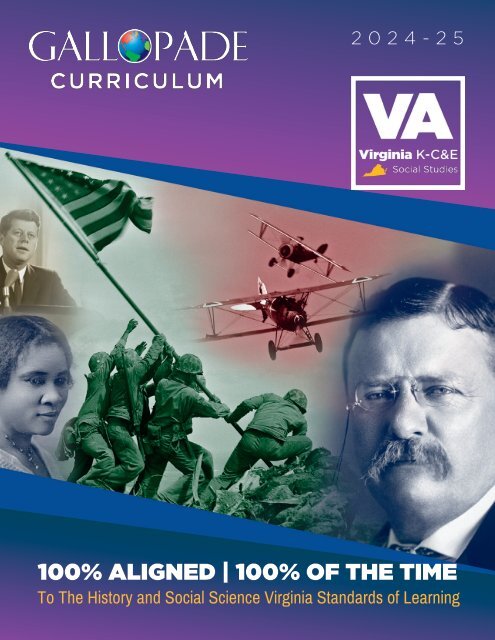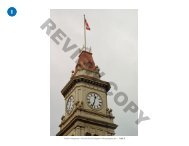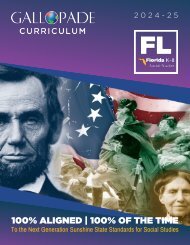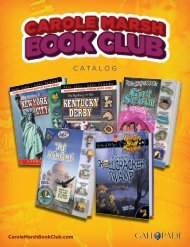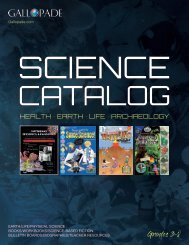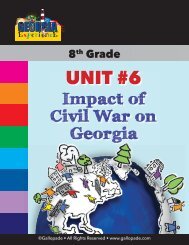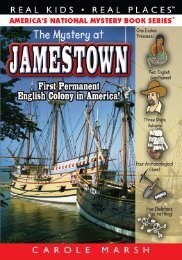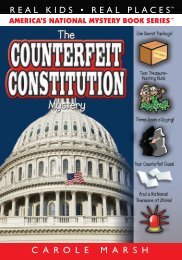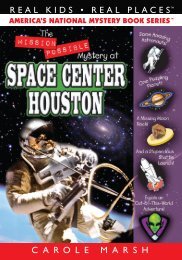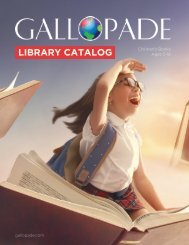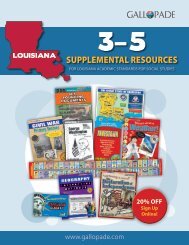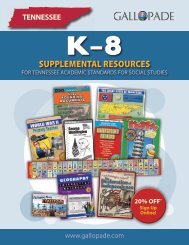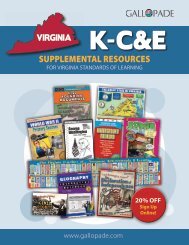Virginia Curriculum Catalog
Create successful ePaper yourself
Turn your PDF publications into a flip-book with our unique Google optimized e-Paper software.
2 0 2 4 - 2 5<br />
100% ALIGNED | 100% OF THE TIME<br />
To The History and Social Science <strong>Virginia</strong> Standards of Learning
GALLOPADE MAKES<br />
TEACHING EASIER<br />
For over 44 years, Gallopade has partnered with<br />
educators to create curriculum and supplemental<br />
resources that provide an array of grade-appropriate<br />
resources to teach, test, and measure for Social<br />
Studies standards mastery.<br />
We offer a comprehensive and flexible program designed<br />
to engage students in a robust and interactive<br />
learning experience 100% aligned to the History and<br />
Social Science <strong>Virginia</strong> Standards of Learning.<br />
Gallopade combines print and digital tools such<br />
as primary source analysis, writing prompts, and<br />
project-based learning to create a dynamic learning<br />
platform built for your state. Gallopade <strong>Curriculum</strong><br />
gives students the tools necessary to thrive in their<br />
academic endeavors as they build their skill sets,<br />
boost their confidence, and develop a passion for<br />
learning.<br />
WHY GALLOPADE?<br />
We make teaching easier and learning fun! Gallopade <strong>Curriculum</strong> incorporates proven methods, abundant<br />
resources, the ability to adjust and differentiate, and the flexibility you need in the classroom - all 100%<br />
aligned with your state’s standards.<br />
Standards Aligned<br />
Gallopade <strong>Curriculum</strong> is written and curated to align<br />
completely with the <strong>Virginia</strong> Standards of Learning.<br />
When standards change, the Gallopade <strong>Curriculum</strong><br />
changes with them.<br />
Evidence-Based<br />
Our proven “small bites” approach helps students<br />
of all learning styles understand and retain essential<br />
Social Studies standards and skills.<br />
Proven<br />
Our partners love our program. Teachers say that<br />
Gallopade <strong>Curriculum</strong> makes their jobs easier, and<br />
they don’t require additional resources to cover<br />
Social Studies standards. Gallopade’s methods and<br />
approach make students more engaged and involved<br />
with the subject.<br />
Organized<br />
Gallopade <strong>Curriculum</strong> provides everything needed<br />
to teach the standards. Content is organized by units<br />
and chapters, allowing teachers to easily locate and<br />
assign content, activities, assessments, and grade<br />
assignments.<br />
Consumable<br />
Students receive new books at the start of each<br />
school year. The Student Book is their own to<br />
mark up and write in, and they can also make<br />
annotations in their digital Student Book.<br />
pg.2 | gallopadecurriculum.com
GALLOPADE<br />
APPROACH<br />
Gallopade <strong>Curriculum</strong> uses multiple evidence-based theories to achieve<br />
success in education. Core strategies throughout the program include<br />
chunking content, interactive learning methods, and an emphasis on<br />
standards-based instruction.<br />
By using the concept of chunking, or “small bites,” students efficiently process<br />
and place knowledge into their short-term memory without overwhelming<br />
their cognitive load.<br />
We pair this approach with reinforcement activities that support<br />
interactive learning. As students work through the lessons<br />
and activities, they engage in critical thinking exercises<br />
related to content.<br />
Other pedagogical methodologies include connecting<br />
prior knowledge to new knowledge, scaffolding<br />
through predictable patterns and routines, formative<br />
and summative assessments, and using<br />
data to improve student performance.<br />
Gallopade <strong>Curriculum</strong> is accessible and appropriate<br />
for a variety of learning styles. Students<br />
are engaged with the subject matter to help<br />
achieve standards mastery and to foster a<br />
passion for Social Studies and lifelong learning.<br />
2024 | pg. 3
GALLOPADE CURRICULUM INCLUDES<br />
Students and educators need a solution that is effective, easy to use, and flexible to allow teacher customization. Gallopade provides<br />
various resources in multiple formats, along with instructional strategies and implementation ideas, so that educators can tailor lessons<br />
to the specific needs of their classes to create an engaging learning experience for students of all learning styles.<br />
STUDENT BOOK<br />
Gallopade combines content with interactive activities to<br />
create a unique Student Book beyond traditional textbooks.<br />
EXPERTRACK ASSESSMENTS<br />
Pre-built assessments covering core content and skills.<br />
Assessments are auto-graded for easy teacher and student<br />
review.<br />
TEACHER’S EDITION<br />
The Teacher’s Edition provides a variety of ready to use<br />
and easily adaptable materials for classroom instruction,<br />
as well as answers to all questions and activities, planning<br />
pages, and pacing guides.<br />
TEACHING TOOLS<br />
Assignable tools and activities that add rigor to instruction<br />
with a focus on inquiry, critical thinking, writing, literacy,<br />
and processing skills.<br />
GRADING + REPORTING<br />
Easily measure and assess student success with district,<br />
school, class, and student-level reports.<br />
GALLOPADE CURRICULUM ONLINE<br />
Gallopade’s online platform empowers teachers with<br />
everything they need to plan, teach, assign, and measure<br />
student success. Students are engaged in a digital learning<br />
experience that is organized, flexible, and easy to use.<br />
BIOGRAPHY READERS<br />
Interactive and informative readers, correlated to the standards,<br />
bring historical figures to life and add to students’<br />
knowledge and comprehension.<br />
ONGOING SUPPORT<br />
When you have questions, we have the answers;<br />
support.gallopade.com puts you in touch with someone<br />
from our Customer Success Team whenever you need<br />
assistance.<br />
pg.4 | gallopadecurriculum.com
location<br />
region<br />
relative location<br />
©Carole Marsh/Gallopade • www.gallopade.com • <strong>Virginia</strong> Studies • Page 11<br />
~ This book is not reproducible. ~<br />
natural features<br />
human features<br />
Location describes where a place is. When we learn about a place’s<br />
location, we can better understand what that place is like.<br />
Let’s learn more about where <strong>Virginia</strong> is located.<br />
Then we can learn more what <strong>Virginia</strong> is like!<br />
United States<br />
North America<br />
V<br />
Correlates with VS.1b; VS.2a<br />
Map Legend<br />
V<br />
North America<br />
United States<br />
<strong>Virginia</strong><br />
STUDENT BOOK<br />
Gallopade combines content and activities in an effective and impactful approach. The Student Book engages students with<br />
an interactive learning experience, implementing easy-to-use content for students while meeting <strong>Virginia</strong> standards.<br />
Student Books are built on the repetitive learning cycle of “small bites” of information, reinforcement activities, and frequent<br />
formative assessments to create an active, effective, and hands-on learning experience.<br />
Throughout the book, robust primary sources enhance learning, deepen understanding, and increase analytical skills.<br />
K- C&E | PRINT + DIGITAL<br />
Student Book Activities Include:<br />
• Reading for Information • Point of View<br />
• Cause and Effect<br />
• Problem-Solution<br />
• Classifying Information • Compare and Contrast<br />
• Primary Source Analysis • Analyze Charts and<br />
• Inference<br />
Graphs<br />
• Critical Thinking<br />
• Timelines<br />
• Map Skills<br />
• Fact or Opinion<br />
• And More!<br />
Chapter 2<br />
VirGinia’s LoCation<br />
Key Terms<br />
Location, Location, Location<br />
Where is <strong>Virginia</strong>?<br />
• <strong>Virginia</strong> is on the planet Earth. But you knew that, didn’t you!<br />
• <strong>Virginia</strong> is on the continent of North America.<br />
• <strong>Virginia</strong> is part of the country known as the United States of America.<br />
• <strong>Virginia</strong> is in the part of the United States known as the Southeast.<br />
No Ordinary Textbook<br />
Gallopade combines content and activities in one innovative program. Students receive<br />
a book that’s theirs to write in and interact with, providing a consumable option that<br />
guarantees standards alignment, year after year.<br />
TEACHER’S EDITION<br />
Designed by teachers for teachers. The Teacher’s Edition is a robust, dynamic, and all-inclusive resource that works for you and<br />
your students. The Teacher’s Edition highlights various ways to introduce the material, teach with supporting differentiation<br />
and extension recommendations, and assess students’ mastery of the content.<br />
The Teacher’s Edition includes guidance on how all tools and resources work together in the classroom, along with pacing<br />
guides, standards correlations for your reference, and Unit and Chapter planners to help build each lesson.<br />
Your Teacher’s Edition provides sample questions that spark inquiry, student-friendly definitions for essential vocabulary,<br />
and Differentiated Learning support. Additionally, suggested materials and tips help you customize lessons for students of<br />
all ability levels.<br />
K-C&E | PRINT + DIGITAL<br />
All-In-One Answer Key<br />
Answers to all the questions and activities in the Student Book<br />
are included in the Teacher’s Edition.<br />
Planning Pages<br />
Planning Pages at the beginning of each lesson or each chapter<br />
give you a place to plan and document your goals, priorities,<br />
calendar, and notes for customized instruction and differentiation<br />
strategies.<br />
By the Standards<br />
Correlations to all State standards are included, offering a<br />
convenient, at-a-glance reference to refer to your standards<br />
at any time, so you can clearly define where each standard is<br />
covered in the curriculum.<br />
Customizable<br />
Materials can be used in various classroom models, including<br />
traditional whole group, rotational learning, mini-lesson format,<br />
group and personal choice boards, and student-led teaching.<br />
Openers<br />
Openers provide instructional strategies to activate existing<br />
knowledge and real-world experiences that spark curiosity<br />
and inquiry.<br />
2024 | pg. 5
<strong>Virginia</strong> Experience • U.S. History II • ©Carole Marsh/Gallopade • www.gallopade.com • Page 2<br />
<strong>Virginia</strong> Experience • U.S. History II • ©Carole Marsh/Gallopade • www.gallopade.com • Page 7<br />
<strong>Virginia</strong> Experience • U.S. History II • ©Carole Marsh/Gallopade • www.gallopade.com • Page 5<br />
<strong>Virginia</strong> Experience • U.S. History II • ©Carole Marsh/Gallopade • www.gallopade.com • Page 1<br />
<strong>Virginia</strong> Experience • U.S. History II • ©Carole Marsh/Gallopade • www.gallopade.com • Page 3<br />
<strong>Virginia</strong> Experience • U.S. History II • ©Carole Marsh/Gallopade • www.gallopade.com • Page 4<br />
2<br />
Building the Transcontinental RailroadThe Weeping Time<br />
When I Grow Up, I Want to Be a Cowboy<br />
It was a race to see who could be the fastest to the finish line. Spikes were driven into<br />
How<br />
the<br />
would you like to be sold like livestock, as if you were a mule? No one would,<br />
Many former slaves left the South and moved west to work on ranches in Texas after<br />
ground; tracks were laid across mountains and plains. It was a project that would change<br />
of course, but it happened…<br />
the Civil War. Driving cattle was a difficult job. It was lonely, dirty, and sometimes<br />
America forever…<br />
dangerous. Imagine how the “Help-Wanted” advertisement might have read...<br />
In 1859 on a racetrack in Savannah, Georgia, the largest sale of slaves ever held in<br />
The construction of the Transcontinental Railroad was one of the greatest<br />
Help Wanted: Cowboys<br />
the United States took place. On two rainy days, about 430 men, women, and children<br />
technological accomplishments in America’s history. Construction started after the<br />
$1 a Day<br />
were sold to the highest bidder.<br />
Civil War ended in order to extend existing tracks in the Great Plains over the western<br />
Attention: Young Men, 15 to 25 years old<br />
mountains, plains, deserts, and rivers. Only then could someone easily and quickly travel Pierce Butler, a plantation owner, had wasted his inheritance on an expensive Twelve cowhands are needed to herd 3,000 longhorn cattle. We’ll travel on horseback,<br />
from the eastern United States to the West. 5<br />
lifestyle. His land and buildings were sold to pay some of his bills, 3but he still owed more<br />
10 to 15 miles a day for two months. We’ll follow the Chisholm Trail. You must be a<br />
money. He needed to sell many of his<br />
Without an unbroken rail route to the<br />
slaves to get out of debt.<br />
good rider and able to rope a calf while riding your horse. You must be willing to herd<br />
Pacific Coast, the trip from the East lasted several<br />
across deep water. The boss will provide lunch and dinner at the chuck wagon. Be<br />
months. It was difficult, expensive, and sometimes<br />
The major slave auction was prepared to take a two-hour turn each night watching the cattle. Singers and storytellers<br />
dangerous. Many people instead chose to take<br />
advertised widely for weeks and drew<br />
are encouraged to apply.<br />
a ship south around the tip of South America<br />
huge crowds to Savannah. Butler had<br />
and then north. But that approach also required<br />
his slaves brought to the racetrack, where<br />
several months and was costly.<br />
they stayed in shacks or horse stalls for Driving a herd of cattle was not easy! Keeping the cattle moving in the right<br />
days or weeks until the sale began. direction could be dangerous.<br />
It didn’t take much to spook<br />
Two railroad companies would start racing<br />
One observer said, “It is a dreadful a Texas longhorn. A loud<br />
toward each other from northern California to<br />
affair….” Not all families were sold noise, like thunder, might<br />
eastern Nebraska. The Central Pacific started<br />
together. Parents and children were cause a stampede. Imagine<br />
laying track from west to east, while the Union<br />
soon parted. So were brothers and 3,000 cattle running on<br />
Pacific built from east to west. The companies<br />
sisters. That observer asked, “Can such the open plain, trampling<br />
competed to be the first to reach Promontory<br />
a system [slavery] endure?” And yet everything he in their path! You’d<br />
Point, Utah, where their tracks would joint!<br />
added, “Slavery is better for them and have to round them up again.<br />
for us….”<br />
Sometimes a cowboy could<br />
Building the railroad was difficult for both companies. The Central Pacific had to<br />
keep them calm by singing.<br />
lay track through the Rocky Mountains. Workers blasted through rock with dynamite Surely, the men, women, boys, and girls standing in the rain that day disagreed.<br />
and built tunnels to make room for the railroad. The Union Pacific’s work was less Many tried hard to be purchased by “good” masters. They showed off their teeth or<br />
There were other dangers.<br />
challenging because it was building across flat prairies. The railroad companies lay an muscles. Others just sat sadly in the rain.<br />
Rattlesnakes, cattle thieves, and<br />
average of 1 mile of track a day.<br />
What happened next? New owners and their new slaves left together. Champagne hostile Indians topped the list. A<br />
On on May 10, 1869, the Central Pacific and Union Pacific crews met at bottles were popped to celebrate the $303,850 made from the sale.<br />
common cause of death for a cowboy was being dragged by his horse after falling off.<br />
Promontory Point. The last spike nailed into the track was made of gold! News of the<br />
The rain stopped. Africans who had been kidnapped and brought against their will Most of the day, you would ride alongside the cattle alone. After the evening meal,<br />
completied Transcontinental Railroad spread quickly, and Americans celebrated the<br />
to work in the fields or do household chores would continue to work hard. you’d sit around the fire and tell stories. Then you’d grab your blanket and get some<br />
joining of East and West.<br />
sleep. Your buddy would wake you when it was your turn at watch.<br />
One day, the terrible practice of slavery would come to an end in America, but not<br />
The creation of the railroad changed the United States forever! Americans could on this day at a racetrack in Savannah.<br />
travel from the East to the West in only a few days and for as little as $150 for a nice seat.<br />
The “Wild” West attracted many new settlers, bustling towns, and settlements along the<br />
Higher-Order Thinking<br />
railroad tracks.<br />
Higher-Order Thinking<br />
Develop a logical argument as to why men would want to become cowboys, since it was<br />
Higher-Order Thinking<br />
What can you conclude about the observer’s point of view of slavery? Cite evidence from<br />
a pretty difficult life.<br />
What effects did the completion of the Transcontinental Railroad have on life in America? the text to support your answer.<br />
Cite evidence from the text that is stated explicitly or inferred.<br />
Tech Tools<br />
Incorporate classroom and “Build Your Own Tech” technology<br />
into your Social Studies instruction with ideas, tips, and links for<br />
integrating research, blogs, flashcards, videos, and more into<br />
instruction and assessments.<br />
Enrichment Pack<br />
Engage students with broad word and world knowledge through<br />
robust reading passages that help them comprehend challenging<br />
material with higher-order thinking and prompts to encourage<br />
class or small group discussion or to inspire writing assignments.<br />
7<br />
The Invention of Paper Living in the Wild, Wild West Recipe for a GREAT Map!<br />
Did you know that Benjamin Franklin was the first paper<br />
The few wooden buildings lining the dirt road didn’t look like much. They had signs like Just as a recipe combines parts to make a whole dish, so does a map include many<br />
merchant in America? Or that he helped start paper mills in<br />
“General Store,” “Blacksmith,” and “Hotel.” The Wild West town looked more like a important pieces to give you the big picture…<br />
<strong>Virginia</strong>? Let’s learn about the history of paper…<br />
dusty row of barns than a bustling city…<br />
A map is a very important geographic tool that shows<br />
Paper is everywhere in a modern society. Just a few of<br />
The towns of the Wild West may have been small and simple, but they were the detailed information about an area. The area can be as small<br />
the ways different types of paper products are used include<br />
center of a pioneer’s life. Just about every Wild West town featured the same businesses<br />
as your classroom or as big as the entire Earth! A map may<br />
writing paper, gift wrap, book pages, Kleenex, and paper<br />
that were important to pioneer life:<br />
show roads, landmarks, routes for transportation, and different<br />
money. Paper is a vital resource for the United States and<br />
for the entire world!<br />
1<br />
Blacksmith and stables: Since horses were the 4<br />
landforms such as mountains and rivers.<br />
main type of transportation, each Wild West town<br />
There are four main parts to a map you need to remember:<br />
It is believed the world’s first paper was created by<br />
needed a blacksmith who could make shoes for<br />
the ancient Egyptians. They used strips from a papyrus<br />
the map title, map key, scale, and compass rose.<br />
the horses, and a stable where horses were fed<br />
plant. These strips were moistened and then made into<br />
and watered.<br />
The map title tells what this map displays. A map key or map legend is a chart that<br />
a criss-cross pattern that the Egyptians pressed into<br />
explains what the symbols on a map mean. On many maps, for example, a black dot<br />
sheets. The word “paper” comes from “papyrus.”<br />
General store: The general store provided the<br />
stands for a city, a star stands for a state’s capital, airplanes stand for airports, and black or<br />
However, the kind of paper the Egyptians made did not<br />
supplies pioneers needed for survival. The stores<br />
yellow lines stand for highways, roads, or<br />
look and feel anything like our paper products of today. Paper that is closest to<br />
were usually very small—the size of an average<br />
streets. The kind of map will determine<br />
modern paper was first made in China nearly 2,000 years ago.<br />
classroom. They carried goods like rugs, cooking<br />
what kind of symbols are needed for the<br />
stoves, candles, hammers, and children’s toys.<br />
map legend.<br />
The Chinese did not experiment with paper for writing. Instead, they needed<br />
a different kind of paper to make clothing and blankets!<br />
Church: The church was the center of town. It<br />
Many maps also have a compass<br />
was a place where settlers could worship and<br />
The Chinese created paper by boiling plants until they became pulp. The<br />
rose, which is a tool that shows<br />
talk with their neighbors. A pastor might have to<br />
pulp would then be sifted through a screen.<br />
directions. The cardinal directions<br />
travel to several different towns to preach—all in<br />
are north, south, east, and west. The<br />
Next, the pulp would harden and dry. The sheets of pulp would be lifted one day!<br />
intermediate directions are the points<br />
from the screen to be used as paper. This paper was very thick and would not<br />
bend like the paper we use today. It was not very smooth, either.<br />
Hotel: The hotel was important for visitors. Since most pioneer houses were one-room<br />
in between the cardinal directions:<br />
log cabins, they did not have room for guests. The hotel room might cost 50 cents per<br />
northeast, northwest, southeast, and<br />
When they wanted to write, the Chinese would scratch or chisel on night, plus 50 cents for lunch and dinner!<br />
southwest.<br />
wood, bamboo, or stone.<br />
Most maps will also have a scale.<br />
Lumberyard/sawmill: Lumberyards were important businesses in prairie towns where<br />
there weren’t many trees to cut down. Pioneers got wood from the lumberyard to<br />
A map scale is a tool that compares distance on a map to the actual distance on Earth. The<br />
build their cabins. Sawmills were important because they cut wood much faster than scale helps the person reading the map figure out real-life distances. For example, suppose<br />
pioneers could cut by hand.<br />
there is a map on which 1 inch represents 1 mile. If two places on that map are 5 inches<br />
Higher-Order Thinking<br />
apart, that means they are 5 miles apart on Earth.<br />
The text says the Chinese used wood, bamboo, or stone for writing. What about School: Wild West towns usually had small, one-room schoolhouses. Students from<br />
writing on those materials might motivate the Chinese to experiment with other kinds ages of 6 to 16 would all learn together from one teacher. Their subjects included reading,<br />
materials?<br />
writing, and arithmetic.<br />
Papyrus<br />
Higher-Order Thinking<br />
Give the four main parts of a map and explain why each is important in understanding<br />
Higher-Order Thinking<br />
how to read a map.<br />
Business tycoon Harvey Firestone once said, “The way of the pioneer is always rough.”<br />
He was referring to business pioneers, but use specific examples from the text and explain<br />
how a real pioneer’s life was a rough one.<br />
Graphic Organizers<br />
Includes over 20 printable or projectable ready-to-use graphic<br />
organizers to increase student comprehension. Students understand<br />
concepts and connections.<br />
Additional Features<br />
• Students can complete their work directly online and use digital<br />
annotation tools.<br />
• The Read Aloud feature supports comprehension and fluency<br />
by having the text spoken aloud while students follow aloud.<br />
TEACHING<br />
TOOLS<br />
From day one, teachers have a comprehensive program<br />
that will prepare every student at every level. Our extensive<br />
teacher materials make it easy to build your daily<br />
lesson plan.<br />
Teaching Tools are organized to match Student Book units<br />
and chapters, making it simple to access the resources<br />
you want to use. Teaching Tools enhance instruction while<br />
easing the burden of your time. You get exactly what you<br />
need when you need it.<br />
K-C&E | Print + DIGITAL<br />
21st Century Skills — Projects and Performance Tasks<br />
Activities can be used as part of an ongoing collaborative<br />
process throughout a unit or as a capstone project at<br />
the end of a unit combining Social Studies content and<br />
essential information into a higher-order thinking activity<br />
or assignment. Each project is easily adaptable to be as<br />
simple or elaborate as desired for your class.<br />
MULTIMEDIA<br />
RESOURCES<br />
Strategically selected resources go beyond the classroom to<br />
engage students with primary and secondary sources. These<br />
enhance lessons and illustrate key concepts with each source<br />
broken down by chapter to save you time.<br />
K-C&E | DIGITAL<br />
Varied Formats<br />
• Photographs<br />
• Diagrams<br />
• Infographics<br />
• Political cartoons<br />
• Paintings<br />
• Videos<br />
• Primary Sources<br />
• Internet Links<br />
Enhanced Learning<br />
• Boost Creativity<br />
• Encourage student<br />
engagement and<br />
collaboration<br />
• Creative alternatives for<br />
learning about specific<br />
topics<br />
• Videos help explain complex<br />
ideas<br />
• Assign as homework or inclass<br />
review<br />
pg.6 | gallopadecurriculum.com
FULL<br />
SCREEN<br />
INTRO<br />
STORY<br />
VOCAB<br />
POP QUIZ<br />
• Easy-to-read stories<br />
• Interactive exercises<br />
• Highlighted events and<br />
achievements<br />
With his printing business going<br />
well, Ben turned it over to his<br />
foreman so he could have more<br />
time for his scientific experiments.<br />
Ben invented the Franklin stove,<br />
which provided more heat and<br />
used less wood than a fireplace.<br />
He also invented the lightning rod<br />
after discovering that lightning<br />
has electricity in it.<br />
Ben learned<br />
about electricity by flying a kite with<br />
a key attached to it during a storm!<br />
• Multi-level student<br />
engagement<br />
• Comprehension-centric<br />
activities and quizzes<br />
BIOGRAPHY<br />
READERS<br />
Biography Readers provide additional information<br />
about notable historical figures featured in student<br />
lessons. Expand students’ knowledge of the life and<br />
contributions of important people and build reading<br />
skills. Each reader includes a glossary, facts, puzzles,<br />
achievement highlights, and more.<br />
PRINT<br />
Included for K-2 | PRINT<br />
Available for <strong>Virginia</strong> Studies & U.S. History I | PRINT<br />
EXPERTRACK<br />
ExperTrack includes pre-built, auto-graded assessments by grade to measure progress. As students apply critical thinking and analysis<br />
skills throughout the year, ExperTrack provides you with results data to influence and customize instruction. Students improve<br />
comprehension, deepen understanding, and strengthen their ability to apply the knowledge and skills they learn through Formative,<br />
Summative, and Benchmark milestones.<br />
ExperTrack assessments can be used in a variety of ways. Teachers can assign as a pre-test or check for understanding and reassign to<br />
provide an opportunity to demonstrate improvements in mastery and comprehension. Teachers can correct misconceptions, provide<br />
remediation, and reinforce learning by projecting or screen-sharing questions and discussing them with their class or in small groups<br />
as needed.<br />
3-C&E | DIGITAL<br />
Question Types<br />
• Multiple Choice<br />
• Order of Events<br />
• Categorization<br />
• Map Skills<br />
• Tables and Charts<br />
• Drag and Drop<br />
• Matching<br />
• Venn Diagram<br />
• And More!<br />
Item Bank<br />
Teachers can create their own assessments using a<br />
pre-existing, standards-aligned bank of questions, allowing<br />
for customization and student personalization.<br />
Checkpoints<br />
Evaluate understanding and comprehension after<br />
each chapter or unit.<br />
2024 | pg. 7
~ This book is not reproducible. ~<br />
Correlates with USI.1b,f; USI.3a,b-c<br />
PUTTING IT<br />
TOGETHER<br />
All elements of Gallopade’s <strong>Curriculum</strong> program provide an<br />
extensive system that allows you to guide students through<br />
a customized learning experience that positively impacts<br />
their mastery of the standards.<br />
Prepare & Assign<br />
Create assignments with Gallopade <strong>Curriculum</strong> Online, browse<br />
resources organized by unit and chapter, and easily choose which<br />
content and activities to assign.<br />
• Schedule assignments for the entire class or individual students<br />
• Plan and document your instructional calendar, including planning<br />
strategies<br />
• Meet learning objectives with accuracy<br />
1 PLANNING<br />
Teacher’s Edition<br />
Plan and document your instructional calendar<br />
and strategies with Unit Planning<br />
Pages. Reference which Teaching Tools are<br />
available online.<br />
Hit Learning Targets with Accuracy<br />
Begin each chapter by planning additional instructional strategies<br />
to use throughout the lesson.<br />
• Writing Prompts<br />
• Group Activities<br />
• Individual Assignments<br />
• Ideas for Project-Based<br />
Learning<br />
• Inquiry-Based Learning<br />
• Formative and Summative<br />
Assessments<br />
• Blended Learning<br />
• And more!<br />
Chapter 5<br />
earLy CuLturaL groups in north aMeriCa<br />
Key Terms<br />
American Indian<br />
natural resources<br />
human resources<br />
capital resources<br />
American Indians Throughout North America<br />
American Indians lived in all areas of North America. Prior to the arrival of Europeans,<br />
American Indians were dispersed across the various environments of North America.<br />
Geography and climate affected how the various American Indian groups met their basic needs.<br />
Resources influenced what they produced and how they produced it.<br />
Natural Resources<br />
things that come directly<br />
from nature<br />
Examples include:<br />
fish caught, wild animals<br />
hunted, and crops grown<br />
by American Indians<br />
Human Resources<br />
people working to<br />
produce goods and<br />
services<br />
Examples include:<br />
American Indians who<br />
fished, made clothing, and<br />
hunted animals<br />
Capital Resources<br />
goods produced and<br />
used to make other<br />
goods and services<br />
Examples include:<br />
canoes, bows, and spears<br />
American Indians made<br />
and used<br />
American Indians Used Available Resources<br />
In the past, American Indians fished, hunted, and grew crops for food. They made clothing<br />
from animal skins and plants. They built shelters from resources like sod, stones, animal<br />
skins, and wood. The precise types of food, clothing, and shelters depended on what<br />
resources they found in their environment.<br />
Reading for Information<br />
archaeology<br />
How did geography, climate, and resources impact the lives of American Indians in<br />
North America?<br />
___________________________________________________________________________<br />
Answers will vary<br />
___________________________________________________________________________<br />
Do It!<br />
21st Century Skills: Projects and Performance Tasks<br />
#1 Starting with this chapter, create a giant timeline and post it on your<br />
classroom wall, showing important events throughout the U.S. History I course.<br />
Organize It!<br />
Graphic Organizers Galore<br />
#14 Put examples of natural resources, human resources, and capital resources<br />
into different buckets.<br />
Do It!<br />
Innovate, innovate, innovate! Assign each student in your class one of the<br />
five early American Indian cultural groups. Ask students to do more research<br />
on the various technologies invented and/or utilized by that cultural group.<br />
Have them pick one technology and focus on how it was developed, what local<br />
resources the cultural group used to create it, and what problem it solved.<br />
Assign students to make a brief presentation to the class, including pictures or<br />
models of the technology. Then let the class vote on which technologies they<br />
find the most innovative.<br />
©Carole Marsh/Gallopade • www.gallopade.com • <strong>Virginia</strong> US I • Page 25<br />
<strong>Virginia</strong> Experience • <strong>Virginia</strong> US I Teacher’s Edition • This book is not reproducible. • ©Carole Marsh/Gallopade • www.gallopade.com<br />
page 29<br />
pg.8 | gallopadecurriculum.com
2 TEACH<br />
Students read, learn, and interact with<br />
their Student Book or eBook, whether<br />
in the classroom or at home.<br />
Comprehension<br />
Activities<br />
• Quizzes and comprehension activities<br />
follow each “small bite” of information,<br />
encouraging students to recall and<br />
analyze learned content<br />
• Students interact with various elements,<br />
including videos, audio, popups,<br />
and other skill-building exercises<br />
3 REINFORCE &<br />
RE-ENGAGE<br />
Gallopade <strong>Curriculum</strong>’s content and resources<br />
combine to enhance and elevate<br />
instruction while ensuring Social Studies<br />
comprehension.<br />
Teaching Tools<br />
Teachers can expand instruction beyond<br />
the Student Book with tools and resources<br />
organized by chapter for reinforcement,<br />
remediation, and enrichment. All Teaching<br />
Tools are available online in digital format<br />
and are printable.<br />
Accessibility<br />
Students can access and interact with<br />
the online Student eBook, highlight,<br />
take notes, and submit completed<br />
activities.<br />
2024 | pg. 9
Super Civil Rights Leader<br />
Assignments<br />
Teacher View<br />
Teachers can view assignments from the<br />
student’s point of view and monitor student<br />
completion.<br />
Student View<br />
Students can easily access the Student eBook<br />
and assigned activities in their Digital Course.<br />
Multimedia Resources<br />
Receive access to multimedia resources, including<br />
videos, images, primary sources, and internet links<br />
within each course.<br />
Read Aloud & Translation<br />
Increase class accessibility with tools designed to<br />
meet UDL requirements and aid students’ attention<br />
and focus.<br />
Biography Readers<br />
Bring historical figures to life while<br />
improving reading skills. Gallopade’s<br />
1000 Readers incorporate activities, fun<br />
facts, and quizzes to help to reinforce<br />
and retain knowledge.<br />
Martin Luther<br />
King, Jr.<br />
Martin became aware<br />
of prejudice and<br />
inequality as a black<br />
child growing up in the<br />
South.<br />
Martin Luther King, Jr., was born on January<br />
15, 1929, in Atlanta, Georgia. He was the son of<br />
Reverend Martin Luther King, Sr., and Alberta<br />
Williams King. Martin’s father was a pastor at a<br />
popular Baptist church in Atlanta.<br />
pg.10 | gallopadecurriculum.com
4 TEST & ASSESS<br />
With ExperTrack, teachers can review core content<br />
and assess skills using the pre-built, auto-graded<br />
assessment questions for each grade – or create<br />
your own assessment using questions from Gallopade’s<br />
item bank.<br />
5 MEASURE & MONITOR<br />
Grading + Reporting<br />
Document students’ progress throughout the school year. Assess<br />
classes and students by standard, content type, and activity.<br />
6 ONGOING SUPPORT<br />
When You Have Questions, We Have Answers<br />
Our team of experts is available to help you with anything you need, from training and support to tips for<br />
navigating your tools and online resources with ease. We’re here to help you succeed – so you can help<br />
students do the same!<br />
Continuous support is available through in-person training, live webinars, knowledge base articles, and<br />
online chat. Our team is proactively involved in your experience to ensure you are using Gallopade <strong>Curriculum</strong><br />
to its full potential.<br />
Support.gallopade.com puts you in touch with a member of our Customer Success team whenever you<br />
need assistance.<br />
2024 | pg. 11
SUPPLEMENTAL RESOURCES<br />
Available for all 50 states!<br />
We offer a variety of supplemental materials<br />
covering Social Studies standards. Enhance<br />
your students’ learning experience with<br />
these state and grade-level specific,<br />
interactive resources.<br />
Scan the QR code or visit Gallopade.com to<br />
browse <strong>Virginia</strong>’s Supplemental Resources.<br />
pg.12 | gallopadecurriculum.com
earLy CuLturaL groups in north aMeriCa<br />
Key Terms<br />
American Indian<br />
natural resources<br />
human resources<br />
capital resources<br />
©Carole Marsh/Gallopade • www.gallopade.com • <strong>Virginia</strong> US I • Page 25<br />
~ This book is not reproducible. ~<br />
Correlates with USI.1b,f; USI.3a,b-c<br />
American Indians lived in all areas of North America. Prior to the arrival of Europeans,<br />
American Indians were dispersed across the various environments of North America.<br />
Geography and climate affected how the various American Indian groups met their basic needs.<br />
Resources influenced what they produced and how they produced it.<br />
things that come directly<br />
from nature<br />
Examples include:<br />
fish caught, wild animals<br />
hunted, and crops grown<br />
by American Indians<br />
people working to<br />
produce goods and<br />
services<br />
Examples include:<br />
American Indians who<br />
fished, made clothing, and<br />
hunted animals<br />
goods produced and<br />
used to make other<br />
goods and services<br />
Examples include:<br />
canoes, bows, and spears<br />
American Indians made<br />
and used<br />
In the past, American Indians fished, hunted, and grew crops for food. They made clothing<br />
from animal skins and plants. They built shelters from resources like sod, stones, animal<br />
skins, and wood. The precise types of food, clothing, and shelters depended on what<br />
resources they found in their environment.<br />
Reading for Information<br />
archaeology<br />
How did geography, climate, and resources impact the lives of American Indians in<br />
North America?<br />
___________________________________________________________________________<br />
___________________________________________________________________________<br />
<strong>Virginia</strong> Experience • <strong>Virginia</strong> US I Teacher’s Edition • This book is not reproducible. • ©Carole Marsh/Gallopade • www.gallopade.com<br />
THERE’S MORE<br />
TO DISCOVER<br />
Try a demo for yourself and see why Gallopade<br />
<strong>Curriculum</strong> is used in thousands of schools<br />
nationwide. Visit gallopadecurriculum.com or<br />
scan the QR code below to get started.<br />
Follow the instructions to create a demo account.<br />
Your account gives you access to Gallopade<br />
<strong>Curriculum</strong> for 30 days.<br />
Chapter 5<br />
American Indians Throughout North America<br />
Natural Resources<br />
Human Resources<br />
Capital Resources<br />
American Indians Used Available Resources<br />
Answers will vary<br />
page 29<br />
Do It!<br />
21st Century Skills: Projects and Performance Tasks<br />
#1 Starting with this chapter, create a giant timeline and post it on your<br />
classroom wall, showing important events throughout the U.S. History I course.<br />
Organize It!<br />
Graphic Organizers Galore<br />
#14 Put examples of natural resources, human resources, and capital resources<br />
into different buckets.<br />
Do It!<br />
Innovate, innovate, innovate! Assign each student in your class one of the<br />
five early American Indian cultural groups. Ask students to do more research<br />
on the various technologies invented and/or utilized by that cultural group.<br />
Have them pick one technology and focus on how it was developed, what local<br />
resources the cultural group used to create it, and what problem it solved.<br />
Assign students to make a brief presentation to the class, including pictures or<br />
models of the technology. Then let the class vote on which technologies they<br />
find the most innovative.<br />
EVALUATION<br />
KITS<br />
Get a first-hand look at Gallopade<br />
<strong>Curriculum</strong> with a FREE Evaluation Kit.<br />
Email us at curriculum@gallopade.com<br />
to request yours today!<br />
Your Evaluation Kit provides online access to all<br />
components included in Gallopade <strong>Curriculum</strong><br />
Class Set and a print version of the <strong>Virginia</strong><br />
Student Book.<br />
SCAN THE QR<br />
CODE TO...<br />
Sign Up for<br />
Updates<br />
Visit Gallopade<br />
Curiculum<br />
2024 | pg. 13
GET IN TOUCH<br />
SALES<br />
Greg Farmer<br />
National <strong>Curriculum</strong> Manager<br />
(470) 344-0608<br />
greg@gallopade.com<br />
SUPPORT<br />
Nancy Wall<br />
Training & Support<br />
(470) 322-4737<br />
nancy@gallopade.com<br />
Mary Davis<br />
<strong>Curriculum</strong> Consultant<br />
(470) 645-3345<br />
mary@gallopade.com<br />
CONTACT US<br />
Call For a Quote: 800.536.2438<br />
Fax: 800.871.2979<br />
Email: orders@gallopade.com<br />
Mail: Gallopade | PO BOX 2779 | Peachtree City, GA, 30269<br />
Order Online: gallopade.com<br />
Scan the QR code to...<br />
SHIPPING & TERMS<br />
Standard Shipping: 3-8 Business Days, 10%, $10 Minimum<br />
TERMS & CONDITIONS<br />
All public institutions and/or established accounts with authorized<br />
purchase orders may charge their orders. Terms are<br />
Net 30 days. Prices are subject to change. Not responsible<br />
for errors or omissions in this catalog. Gallopade is the sole<br />
source provider for Gallopade <strong>Curriculum</strong> and all its products.<br />
Please include or mention catalog code VA24-25 on all<br />
orders.<br />
View Custom Quote Form<br />
Sign up for Updates<br />
@gallopadeinternational @gallopadeintl @gallopade @gallopadekids @gallopadebooks<br />
pg.14 | gallopadecurriculum.com
VIRGINIA PRICING<br />
Save more with multi-year adoptions! Contact us or visit gallopadecurriculum.com for more pricing information* and custom quotes.<br />
New books are shipped each year with multi-year adoptions. Please include or mention <strong>Catalog</strong> Code VA24-25 on all orders.<br />
Grade<br />
Level<br />
Student<br />
Book &<br />
eBook<br />
Teacher’s Edition<br />
& eBook<br />
Online<br />
Teaching Tools<br />
& Multimedia<br />
Resources<br />
Online<br />
ExperTrack<br />
Assessments<br />
Online Grading &<br />
Reporting<br />
Online Platform<br />
& Student Course<br />
Biography<br />
Readers<br />
Starting Price for<br />
1 Year<br />
30 Students<br />
K <br />
$353.10<br />
$11.77 per<br />
student/year<br />
1st <br />
$540<br />
$18.00 per<br />
student/year<br />
2nd <br />
$683.70<br />
$22.79 per<br />
student/year<br />
3rd <br />
$480<br />
$16.00 per<br />
student/year<br />
VS <br />
$630<br />
$21.00 per<br />
student/year<br />
US1 <br />
$630<br />
$21.00 per<br />
student/year<br />
US2 <br />
$630<br />
$21.00 per<br />
student/year<br />
C&E <br />
$630<br />
$21.00 per<br />
student/year<br />
*All information is current as of the print date. Prices are subject to change. Not responsible<br />
for errors or omissions in this catalog. Contact Gallopade for the best price.<br />
2024 | pg. 15
2024-25<br />
P.O. Box 2779<br />
Peachtree City, GA 30269<br />
TEL: 800-536-2438<br />
FAX: 800-871-2979<br />
gallopadecurriculum.com<br />
gallopade.com<br />
View a Demo<br />
& Request a<br />
Sample at<br />
gallopadecurriculum.com<br />
Scan the QR Code to<br />
View this <strong>Catalog</strong> Online<br />
K-C&E | 2024<br />
VIRGINIA<br />
Social Studies<br />
Your Trusted Partner in Education


